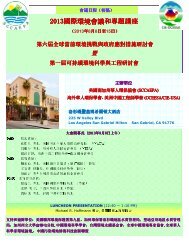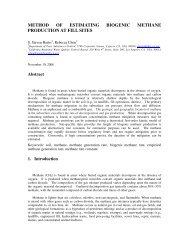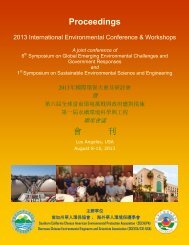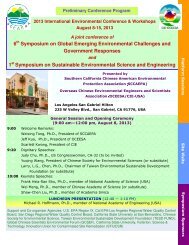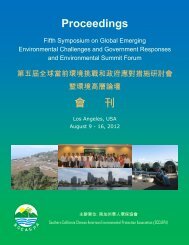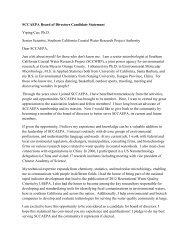Proceedings æ å - SCCAEPA SPONSORS
Proceedings æ å - SCCAEPA SPONSORS
Proceedings æ å - SCCAEPA SPONSORS
Create successful ePaper yourself
Turn your PDF publications into a flip-book with our unique Google optimized e-Paper software.
specific surface area and morphology of the samples were characterized with X-ray diffraction (XRD),<br />
Nitrogen adsorption-desorption, and Scanning electron microscopy (SEM). In this study, we prove the<br />
Pb2+ adsorption effect by this kind of mesoporous materials as an adsorbent for sewage. The<br />
experimental results show that adsorption rates to Pb2+ through this mesoporous materials could be over<br />
95% under the condition that its pH more than 4, adsorption equilibrium can be finished in ten minutes.<br />
The result proves the material has relatively good adsorption effect.<br />
Keywords: biomass ash, mesoporous materials, heavy metal icon, adsorption<br />
Analysis of Present Situations of Industrial Carbon Emissions and Its Decoupling Relationship<br />
with Economic Development in the Central China<br />
Pei-jiang Zhou 1, Wei Hang 1 , Lian-lian Nie 1 , Wei-li Gao 2<br />
1.School of Resource and Environmental Science, Hubei BiomassResource Chemistry and Environm<br />
ental Biotechnology Key Laboratory, Wuhan University, Wuhan, 430079, China 2.Wuhan Donghu<br />
University, Wuhan, 430212, China, Email: zhoupj@whu.edu.cn, hw1027@live.cn,<br />
657480941@qq.com, gwlwhu@tom.com<br />
Abstract: In order to establish reasonable developing route and provide the basis for realizing better low<br />
carbon economy for the central China, the analyzes of the present situations and the decoupling<br />
relationship between industrial carbon emissions and economic development of Hubei, Hunan and Henan<br />
province from 2000 to 2010 in the central China is explored in this paper. The analysis of the present<br />
situations includes industrial carbon emissions, industrial carbon emissions intensity and industrial carbon<br />
emissions per capita of these provinces in the past 10 years. The decoupling relationship between carbon<br />
emissions and energy consumption, between energy consumption and economic growth, and the<br />
influence between carbon emissions and economic growth are investigated by use of the Tapio model.<br />
The results show that it has been realized the weak delinking between industrial carbon emissions and<br />
economic growth in these provinces since 2002. However, the decoupling elastic coefficient is not small<br />
enough and it has always been fluctuated with the time. The influences between industrial carbon<br />
emissions and economy are mainly the energy structure and the low energy efficiency. So it will take a<br />
long time to reach the goal of realizing the intensive delinking, which also proves the great possibility of<br />
reduction in the central China.<br />
Keywords: the central China; industrial carbon emissions; decoupling; Tapio model<br />
Optimization of phase time of SBR combined with simultaneous nitrification and<br />
denitrification and denitrifying dephosphatation<br />
Guangcan Zhu( 朱 光 灿 ) Xiaofen Lei( 雷 晓 芬 ) Xiwu Lu*( 吕 锡 武 )<br />
School of Energy and Environment, Southeast University, Nanjing, Jiangsu 210096, China<br />
Email: gc-zhu@seu.edu.cn, leixiaofen1988@126.com, 101002241@seu.edu.cn<br />
Office Tel: +86 (25) 8379 5515<br />
Abstract: A sequencing batch reactor (SBR) was operated to combined both simultaneous nitrification<br />
and denitrification (SND) and denitrifying dephosphatation processes. The system reduced the oxygen<br />
demand and excess activated sludge production and was investigated for domestic sewage treatment<br />
with low ratio of COD/N. The process was composed of seven stages: feeding-anaerobic phosphorus<br />
release-SND-denitrifying dephosphatation-aerobic-sedimentation- drainage. With the temperature of<br />
25~28oC, MLSS of 3200±58mg/L and water filling ratio of 66%, the influent and effluent concentrations of<br />
COD, TN, NH4+-N and TP were 200±5 vs. 9.0mg/L , 40±2 vs. 8.2mg/L, 40±2 vs. 0mg/L and 8±0.4 vs.<br />
0.59mg/L, respectively. The optimized stage duration periods for anaerobic stage, SND stage, denitrifying<br />
dephosphatation stage and aerobic stage were 2h, 3h, 3.5h and1h, respectively. 42.2% of COD was<br />
removed at the end of anaerobic phosphorus release stage when the ORP variation rate dramatically<br />
decreased to almost zero. DO was maintained at 1 mg/L during the SND stage and rapidly rose when<br />
NH4+-N was completely consumed. pH started to increase instead of decrease when the denitrifying<br />
dephosphatation stage was over. TN removal rate was 72.56% in SBR. The nitrogen removal rates by<br />
SND and denitrifying dephosphatation was 11.24% and 76.92%, respectively. Meanwhile, 89.6% of TP<br />
was removed in SBR and the removal rate of TP was 95.2% during the denitrifying dephosphatation<br />
stage. The findings provided the effective nitrogen and phosphorus removal strategies for low C/N<br />
sewage.<br />
Keywords: sequencing batch reactor (SBR), denitrifying dephosphatation, simultaneous nitrification and<br />
denitrification (SND), optimization of phase time<br />
58



